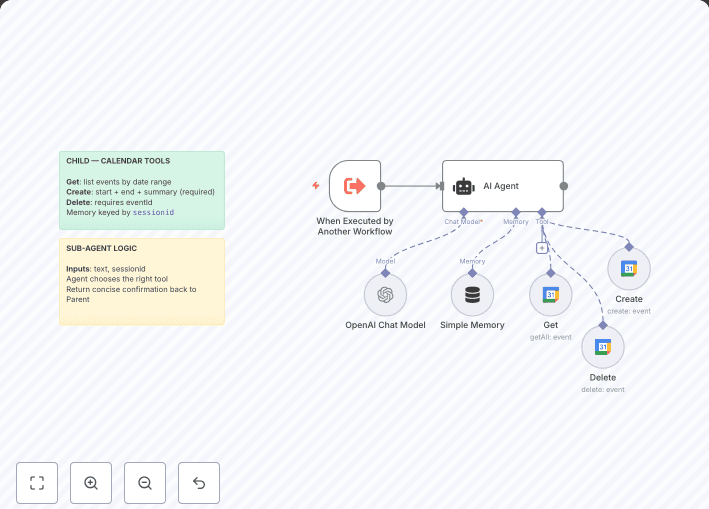This workflow integrates a Retrieval-Augmented Generation (RAG) system with a post-sales AI agent for WooCommerce. It combines vector-based search (Qdrant + OpenAI embeddings) with LLMs (Google Gemini and GPT-4o-mini) to provide accurate and contextual responses.
Both systems are connected to VAPI webhooks , making the workflow usable in a voice AI assistant via Twilio phone numbers.
The workflow receives JSON payloads from VAPI via webhooks, processes the request through the appropriate chain (Agent or RAG), and sends a structured response back to VAPI to be read out to the user.
Advantages
- ✅ Unified AI Support System : Combines knowledge retrieval (RAG) with transactional support (WooCommerce).
- ✅ Data Privacy & Security: Enforces strict email/order verification before sharing information.
- ✅ Multi-Model Power : Leverages both Google Gemini and OpenAI GPT-4o-mini for optimal responses.
- ✅ Scalable Knowledge Base : Qdrant vector database ensures fast and accurate context retrieval.
- ✅ Customer Satisfaction : Provides real-time answers about orders, tracking, and store policies.
- ✅ Flexible Integration : Easily connects with VAPI for voice assistants and phone-based customer support.
- ✅ Reusable Components : The RAG part can be extended for FAQs, while the post-sales agent can scale with more WooCommerce tools.
How it Works
It has two main components:
-
RAG System (Knowledge Retrieval & Q&A)
- Uses OpenAI embeddings to store documents in Qdrant.
- Retrieves relevant context with a Vector Store Retriever.
- Sends the information to a Question & Answer Chain powered by Google Gemini.
- Returns precise, context-based answers to user queries via webhook.
-
Post-Sales Customer Support Agent
-
Acts as a WooCommerce virtual assistant to:
- Retrieve customer orders (
get_order, get_orders).
- Get user profiles (
get_user).
- Provide shipment tracking (
get_tracking) using YITH WooCommerce Order Tracking plugin.
-
Enforces strict verification rules : customer email must match the order before disclosing details.
-
Communicates professionally, providing clear and secure customer support.
-
Integrates with GPT-4o-mini for natural conversation flow.
Set Up Steps
To implement this workflow, follow these three main steps:
1. Infrastructure & Credentials Setup in n8n:
- Ensure all required nodes have their credentials configured:
- OpenAI API Key: For the
GPT 4o-mini and Embeddings OpenAI nodes.
- Google Gemini API Key: For the
Google Gemini Chat Model node.
- Qdrant Connection Details: For the
Qdrant Vector Store1 node (points to a Hetzner server).
- WooCommerce API Keys: For the
get_order, get_orders, and get_user nodes (for magnanigioielli.com).
- WordPress HTTP Auth Credentials: For the
Get tracking node in the sub-workflow.
- Pre-populate the Vector Database: The RAG system requires a pre-filled Qdrant collection with your store's knowledge base (e.g., policy documents, product info). The "Sticky Note2" provides a link to a guide on building this RAG system.
2. Workflow Activation in n8n:
- Save this JSON workflow in your n8n instance.
- Activate the workflow. This is crucial, as n8n only listens for webhook triggers when the workflow is active.
- Note the unique public webhook URLs generated for the
Webhook (post-sales agent) and rag (RAG system) nodes. You will need these URLs for the next step.
3. VAPI Configuration:
- Create Two API Tools in VAPI:
- Tool 1 (Post-Sales): Create an "API Request" tool. Connect it to the n8n
Webhook URL. Configure the request body to send parameters email and n_order based on the conversation with the user.
- Tool 2 (RAG): Create another "API Request" tool. Connect it to the n8n
rag webhook URL. Configure the request body to send a search parameter containing the user's query.
- Build the Assistant: Create a new assistant in VAPI. Write a system prompt that instructs the AI on when to use each of the two tools you created. In the "Tools" tab, add both tools.
- Go Live: Add a phone number (e.g., from Twilio) to your VAPI assistant and set it to "Inbound" to receive customer calls.
Need help customizing?
Contact me for consulting and support or add me on Linkedin.


